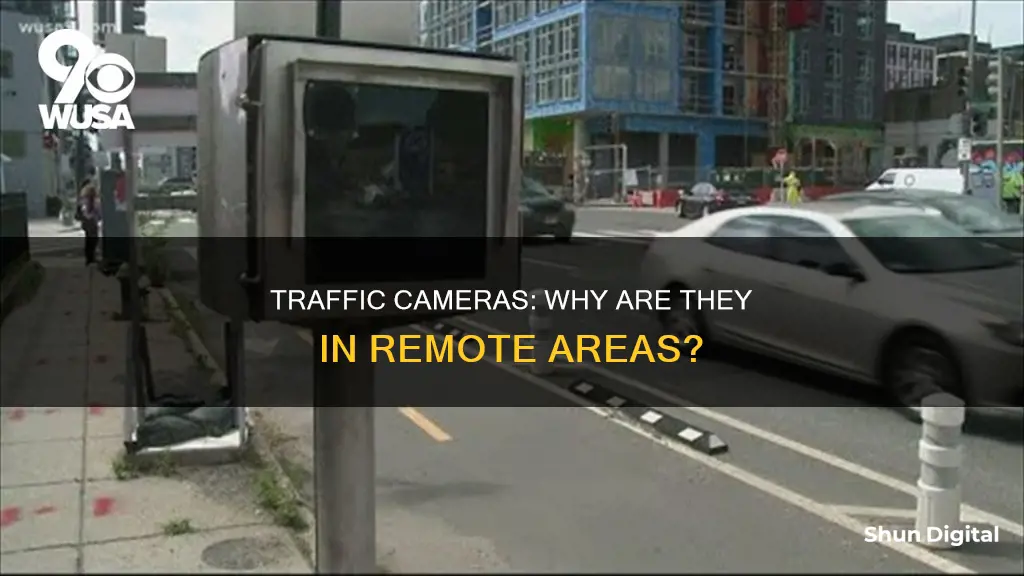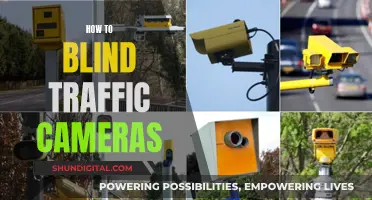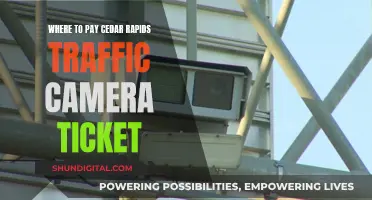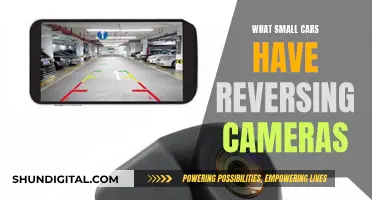
Traffic cameras are usually mounted beside or over a road or installed in an enforcement vehicle to detect and prevent motoring offenses, including speeding, vehicles running red lights, unauthorized use of bus lanes, or recording vehicles inside a congestion charge area. In Texas, small cameras mounted on traffic signals are part of a video imaging system that uses low-resolution cameras to detect the presence of cars and manage traffic flow through intersections and long corridors.
| Characteristics | Values |
|---|---|
| Purpose | Detecting motoring offences, including speeding, vehicles going through a red traffic light, vehicles going through a toll booth without paying, unauthorized use of a bus lane, or for recording vehicles inside a congestion charge area |
| Mounting | Mounted beside or over a road or installed in an enforcement vehicle |
| Link to ticketing system | May be linked to an automated ticketing system |
| Privacy concerns | Loss of privacy and the potential for governments to establish mass surveillance of vehicle movements and therefore by association also the movement of the vehicle's owner |
| Use in Texas | Not used for red-light cameras, which have been banned since 2019, but used for monitoring traffic flow through intersections and long corridors |
What You'll Learn
- To monitor and manage traffic flow through intersections and corridors
- To detect and deter motoring offences, such as speeding or running red lights
- To help emergency vehicles like ambulances get right-of-way at intersections
- To monitor traffic patterns and study traffic flow for urban planning
- To identify vehicles involved in criminal activities or traffic violations

To monitor and manage traffic flow through intersections and corridors
Traffic cameras are often installed to monitor and manage traffic flow through intersections and corridors. These cameras are usually mounted on top of traffic light arms and are part of a video imaging system that uses low-resolution cameras to detect the presence of cars. They are also used to monitor and manage traffic flow through long corridors.
The cameras are typically white and sometimes attached to a connecting pole. They are positioned to have a wide view of approaching cars. A "zone" is drawn within the camera's view, and the system monitors the number of waiting cars stopped at a light. When there is a specified change in the number of vehicles, the camera notifies the signal to change its lights.
In addition to the cameras, other types of traffic sensors or detection systems are also used. For example, Dallas primarily uses radar detectors, which are white panels attached to the traffic light arms. These detectors use radar technology to detect vehicles and trigger the traffic lights.
The use of traffic cameras and other sensors helps to manage the flow of traffic through intersections and corridors, improving traffic management and reducing congestion. By monitoring the number of vehicles and adjusting the traffic signals accordingly, these systems can help to optimize the flow of traffic and reduce wait times for drivers.
Traffic cameras can also be used for other purposes, such as enforcing traffic rules, including speed limits and red-light violations. However, the use of red-light cameras has been banned in some states, such as Texas, raising questions about their purpose. Overall, traffic cameras play a crucial role in monitoring and managing traffic flow, contributing to safer and more efficient transportation systems.
Mastering Autofocus: The Cinema Camera Advantage
You may want to see also

To detect and deter motoring offences, such as speeding or running red lights
Traffic enforcement cameras are often mounted beside or over roads or installed in enforcement vehicles to detect and deter motoring offences. These cameras can identify speeding, vehicles running red lights, unauthorised use of bus lanes, or vehicles inside congestion charge areas. They may also be linked to an automated ticketing system.
A worldwide review of studies found that speed cameras led to an 11% to 44% reduction in "fatal and serious injury crashes". The UK Department for Transport estimated that cameras led to a 22% reduction in personal injury collisions and 42% fewer people being killed or seriously injured at camera sites. The British Medical Journal reported that speed cameras effectively reduced accidents and injuries and recommended wider deployment.
In addition to speed and red light enforcement, these cameras can be used for bus lane enforcement, toll booth enforcement, and congestion charge enforcement. For example, in Melbourne, Australia, automatic number-plate recognition (ANPR) cameras were introduced at the airport to monitor bus lanes and charge vehicles based on their type and dwell time.
While these cameras have been proven effective in reducing accidents and improving road safety, some critics argue that they invade privacy and enable mass surveillance of vehicle movements. There are also concerns about the potential for governments to use this technology for revenue generation rather than solely for improving road safety.
To address these concerns, it is essential to have strict regulations and oversight regarding the use and placement of traffic enforcement cameras, ensuring that they are used solely for their intended purpose of enhancing road safety and reducing accidents.
Uninstalling Camera Raw: A Step-by-Step Guide
You may want to see also

To help emergency vehicles like ambulances get right-of-way at intersections
Traffic cameras are often mounted in seemingly random locations, including in the middle of nowhere, to help emergency vehicles like ambulances get right-of-way at intersections. These cameras are part of a ""traffic preemption system"" that allows emergency vehicles to pass through intersections safely. When the camera receives a signal from inside the emergency vehicle, it automatically changes the traffic lights to green, giving the emergency vehicle the right-of-way. Once the vehicle has passed, the signal returns to its regular operation.
These traffic preemption systems are essential for helping emergency vehicles navigate through busy intersections quickly and safely. By giving them priority at intersections, they can reduce response times and get to their destinations faster. This can be crucial in emergencies where every second counts, such as rushing a patient to the hospital or responding to a fire.
The cameras used in these systems are typically small and black, and they may be mounted on top of traffic lights or on a connecting pole. They use infrared sensors or other technologies to detect the presence of emergency vehicles and trigger the signal change. While these cameras may not be as noticeable as other types of traffic cameras, they play a vital role in ensuring the smooth and efficient movement of emergency vehicles.
In addition to helping emergency vehicles, these traffic cameras can also improve overall traffic flow at intersections. By detecting the presence of vehicles and monitoring the number of waiting cars, the cameras can notify the signal to change its lights at the appropriate times. This helps to manage the flow of traffic and reduce congestion, making the roads safer and more efficient for all drivers.
While some people may confuse these cameras with red-light cameras, it's important to note that red-light cameras have been banned in Texas since 2019. The small cameras mounted on traffic signals serve a different purpose and are used to detect vehicles and manage traffic flow, rather than enforce red-light violations.
Choosing the Right Microphone for Selfie-Mode Photography
You may want to see also

To monitor traffic patterns and study traffic flow for urban planning
Traffic cameras are often installed to monitor traffic patterns and study traffic flow for urban planning. They can be used to detect motoring offences, such as speeding, vehicles running red lights, or unauthorised use of bus lanes. However, they also have an important role in understanding and improving traffic flow.
Traffic cameras are useful tools for urban planning and traffic management. By monitoring traffic patterns, these cameras can identify areas of congestion and help develop strategies to improve traffic flow. This data can inform decisions about road infrastructure, such as adding new lanes or adjusting traffic signal timing. For example, if a particular intersection consistently experiences high volumes of traffic, the city may choose to widen the road or implement a traffic light sequence that gives priority to the busier route.
Additionally, traffic cameras can be used to study the impact of changes in road infrastructure. For instance, after a new road is built, cameras can be used to monitor how this affects traffic flow on surrounding roads and whether the new road is effectively reducing congestion in the area. This information can then be used to fine-tune traffic management strategies and ensure that roads are being used efficiently.
Furthermore, traffic cameras can be used to gather data on traffic patterns at different times of the day or on different days of the week. This information can help urban planners understand how traffic flow changes throughout the day and week, allowing them to implement time-based solutions. For example, if a particular road experiences high volumes of traffic during morning and evening rush hours, the city may choose to implement temporary traffic calming measures during those times to improve safety and reduce congestion.
By monitoring traffic patterns and studying traffic flow, traffic cameras play a crucial role in urban planning and traffic management. They provide valuable data that can inform decisions about road infrastructure and traffic management strategies, ultimately helping to improve traffic flow and reduce congestion in our cities.
Are Toledo's Camera-Issued Speeding Tickets Legally Valid?
You may want to see also

To identify vehicles involved in criminal activities or traffic violations
Traffic cameras are often mounted in remote areas to identify vehicles involved in criminal activities or traffic violations. These cameras are usually installed by the side of the road or on enforcement vehicles to monitor and detect motoring offenses, such as speeding, running red lights, unauthorized use of bus lanes, or toll booth evasion. The latest automatic number-plate recognition systems can also be used to detect average speeds and identify untaxed, uninsured, or stolen vehicles.
These traffic enforcement cameras play a crucial role in enhancing road safety and reducing accidents. Studies have shown that speed cameras, for instance, can lead to a significant reduction in fatal and serious injury crashes. For instance, a worldwide review of studies found that speed cameras reduced such crashes by 11% to 44%. Similarly, the UK Department for Transport estimated a 22% decrease in personal injury collisions and a 42% reduction in fatalities or severe injuries at camera sites.
Beyond road safety, traffic cameras can also aid in mass surveillance of vehicle movements, which has raised concerns about privacy loss. However, authorities often justify this as a necessary measure to identify and apprehend criminals. For instance, automatic number-plate recognition systems can be used to track the movement of vehicles and their owners, helping law enforcement agencies locate and capture offenders.
Additionally, traffic cameras can be used to enforce traffic rules and issue tickets to violators. For example, red-light cameras capture images of vehicles running red lights, and speed cameras monitor compliance with speed limits. This helps maintain order on the roads and ensures that traffic rules are followed.
In summary, traffic cameras mounted in remote areas serve as a valuable tool for law enforcement, aiding in the identification of vehicles involved in criminal activities or traffic violations. They enhance road safety, assist in mass surveillance, and facilitate the enforcement of traffic rules.
Accurate Metering: The Best Camera Mode for Precision
You may want to see also
Frequently asked questions
Traffic cameras are often used to detect motoring offences such as speeding, red-light violations, and unauthorized use of certain lanes. They are usually installed to improve road safety and reduce accidents and injuries.
Studies have shown that speed cameras can lead to a significant reduction in fatal and serious injury crashes. For example, a review of studies found that speed cameras reduced collisions resulting in injuries by 11% to 44%.
Yes, there are concerns about loss of privacy and the potential for governments to establish mass surveillance of vehicle movements. Additionally, some people may view traffic cameras as a revenue-raising tool rather than a road safety measure.







